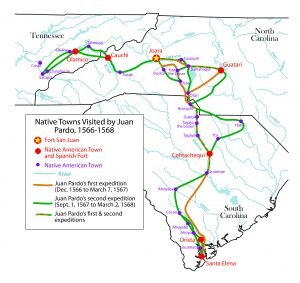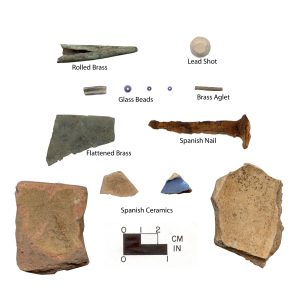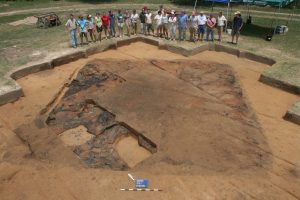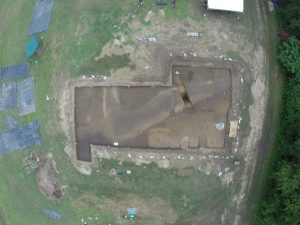Fort San Juan (Burke County)
The Berry site (31BK22), near Morganton in Burke County, is the location of a large Native American town (Joara) and a 16th-century Spanish colonial outpost (Cuenca and Fort San Juan). The Native American town dates from about A.D. 1400 through perhaps 1600, although Archaic-period projectile points and Woodland-period pottery and projectile points are found at the site, and the broad floodplain where the site is located was certainly home to Native Americans for several thousand years. The Berry site is primarily associated with the Burke phase, which was contemporary with the Pisgah and Qualla phases west of Burke County in the Appalachian Summit region. During this time, the settlement was one of the largest Native American towns in North Carolina.
Spanish Encounters

The Berry site was visited by both the Hernando de Soto (1539-1543) and Juan Pardo (1566-1568) expeditions during the mid-16th century. The Soto accounts refer to the town as Xuala and describe it as being “on a plain between two rivers.” Soto and his army rested at Xuala for several days in May 1540 before crossing into the Applachians, but Juan Pardo and his expedition would invest far more in their relations with the town, which they knew as Joara. Juan Pardo and his men arrived at the main town—at the Berry site—in December 1566, having marched there from Santa Elena, the Spanish colonial capital of La Florida located on modern-day Parris Island, South Carolina. Pardo and his men built Fort San Juan at Joara and founded the Spanish colonial town of Cuenca. Their presence was as part of a long-term attempt to establish Spanish colonial outposts along a permanent overland route connecting Santa Elena with New Spain, and the Spanish silver mines near Zacatecas, Mexico.
Pardo and his men visited several other Native American towns in the Carolinas and eastern Tennessee, building four other forts and one casa fuerte (strong house) at different Native American towns. Fort San Juan and Cuenca were intended to be the largest and most important of these Spanish outposts, and Pardo succeeded at first in developing favorable diplomatic relationships with the people of Joara, in part through offering European goods like beads, cloth, and iron tools as gifts. But the soldiers’ demands for food placed an unsustainable burden on their host communities, while violent encounters between some of Pardo’s men and indigenous peoples led Native Americans throughout the region to attack and destroy Fort San Juan and all of Pardo’s other forts in the spring of 1568.
After the destruction of these colonial outposts, the focus of Spanish colonialism in the American South shifted from exploration and military operations to missionization and trade. Archaeological investigations at the Berry site have begun to unearth the remnants of Fort San Juan, the domestic structures built by the people of Joara and by Spanish soldiers to house Pardo and his men, an earthen mound and monumental town pole, and other structures and features related to the Native American occupation at the site, as well as many items of Native American and 16th-century Spanish material culture.
History of Archaeological Investigations

The Berry site was first described by the Smithsonian Institution in 1891 as the location of an earthen mound—15 feet high and unexplored—on the west bank of Upper Creek, eight miles north of Morganton. Bishop August Spangenberg had visited the upper Catawba Valley to survey land for a future Moravian settlement in 1752, and his diary refers to an “Indian Fort” that could be the Berry site, or perhaps refers another site in the region. Archaeologists and local artifact collectors periodically recovered artifacts from the ground surface at the Berry site throughout the 1900s, and sometime during the early-to-mid 1900s, the earthen mound was plowed down.
Modern archaeological excavations at the Berry site began in the 1980s, when David Moore conducted archaeological surveys and excavations in the upper Catawba and Yadkin valleys as part of an effort to better understand the Native American cultural landscape in these areas at the time of early Spanish expeditions across the American South. Moore conducted extensive excavations at Berry in 1986, but it was not until 1994 that Robin Beck and Moore identified the first Spanish artifacts from the site. After comparing these artifacts with those recovered by archaeologists at Santa Elena, Beck and Moore identified the Berry site as Joara, location of Cuenca and Fort San Juan.
Beck’s regional archaeological survey in the 1990s revealed that Berry is one of the largest Burke phase sites in the region and the focal point of a regional settlement hierarchy, with many smaller sites located upstream and downstream. Most of these smaller sites were probably subject to the mico, or chief, who lived at Berry. Geophysical surveys and test excavations at Berry identified evidence of intact burned buildings and other archaeological features. In 2001, Moore and Beck were joined by Chris Rodning. Together they resumed investigations at the site with a focus on colonial encounters between Native Americans and 16th-century Spanish conquistadors and colonists. Excavations and analyses have continued each year since. The research at Berry has led to investigations of other sites nearby, as well as to the founding of the not-for-profit Exploring Joara Foundation, which promotes public awareness of archaeology and history in the Western Piedmont.
Archaeological Finds and Interpretation
The scatter of potsherds, stone tool debris, animal bones, and other Native American artifacts on the ground surface at Berry extends several hundred meters south of the mound and fort, following the course of Upper Creek to the point at which it bends to the west, flowing towards its confluence with Irish Creek. Excavations have shown that Pardo and his men placed Fort San Juan and Cuenca at the northern edge of the site, such that the Native American town seems to have occupied the southern portion of the floodplain. The site as a whole covers roughly five hectares (about 12 acres), making it the largest known Native American site in the upper Catawba Valley and other areas of western North Carolina. There is a slight topographic rise at the site, corresponding to the locations of the mound and the fort.
Despite the fact that farmers plowed down the Berry site mound in the 1940s, an intact remnant of the earthwork remains. Moore’s excavations in 1986 unearthed evidence of at least one mound stage built by basketloading. Additional parts of the Native American town that likely precede the Spanish occupation included hearths, pit features, apparent structures, and postholes near the mound, as well as some postholes that were emplacements for one or more very large town marker posts.

Near the mound, in an area of roughly one hectare at the northern edge of the site, are the remains of at least five burned structures, each built with materials typical of Native American architecture in the greater southern Appalachians. Most of these buildings, with the exception of one that may have served as a Spanish kitchen, resemble the structures found at precontact sites in the Appalachian Summit but are different from the kinds of structures at Native American towns and villages in the eastern Piedmont. These structures and nearby pit features make up the domestic compound where Pardo’s soldiers lived. While most of the architectural styles reflect Native American techniques, some of the wood for the buildings was harvested and shaped with metal tools. The buildings therefore combine Native and Spanish elements.

Artifacts from this area of the site include both Native American materials, especially pottery, and a smaller assemblage of 16th-century Spanish items such as wrought iron nails, chain mail and jackplate armor, iron buckles, copper alloy aglets, copper alloy bells, earthenware and majolica, and glass beads. Some copper alloy items, including rolled beads and pieces of brass or copper scrap, may be items that the people of Joara crafted out of scrap metal acquired from Pardo and his men. Native American pottery, clay and stone smoking pipes, clay and stone gaming disks, and chipped stone projectile points and tools from this part of the site reflect the presence of people from Joara in the compound. Nonlocal forms of Native American pottery probably reflect periodic visits to—or even residence within—the compound by Native people from other areas. Bones of deer, bear, turtle, and turkey indicate that Pardo and his men had access to those kinds of foods, most of which was likely provided by the people of Joara. Charred plant remains, especially from maize and nuts as well as some examples of beans and squash, likewise indicate that women from Joara prepared meals for Pardo and his men that were similar to the kinds of meals they prepared for their own families.

Southeast of the mound are remnants of Fort San Juan itself, including a dry moat, earthen deposits on the inner and outer edges of the moat, and several pit features that are not yet excavated. Excavations, soil coring, and geophysical surveys have revealed the overall footprint of the fort, which is trapezoidal in shape with triangular projections at each corner. Fort San Juan is thus the same shape as Fort San Felipe, which Pardo and his men built at Santa Elena before they marched inland. It is less than half of San Felipe’s size, though, covering about the same area as a modern basketball court. Trenches excavated across the dry moat have revealed that it was about two meters deep with steep sides and a “V” shaped profile. Careful study of soil stratigraphy suggests that parts of the moat may have begun to erode soon after it was dug, and that Pardo’s soldiers made some attempts to repair and “reexcavate” it during the 18 months of the Spanish occupation.
The Berry site—location of Joara, Cuenca, and Fort San Juan—offers some of the most exciting colonial-period archaeology in the United States. Continued research at the site promises to yield new insights into the earliest encounters between Native peoples and European newcomers, insights with relevance both for the archaeological community and to the people of North Carolina.
Contributors
Christopher B. Rodning (Department of Anthropology, Tulane University)
David G. Moore (Department of Sociology and Anthropology, Warren Wilson College)
Robin A. Beck (Department of Anthropology, University of Michigan)
Abra Johgart (Archaeology Laboratory, Warren Wilson College)
Sources
Beck, Robin A., Christopher B. Rodning, and David G. Moore (editors)
2016 • Fort San Juan and the Limits of Empire: Colonialism and Household Practice at the Berry Site. University Press of Florida, Gainesville.
Hudson, Charles
1997 • Knights of Spain, Warriors of the Sun: Hernando de Soto and the South’s Ancient Chiefdoms. University of Georgia Press, Athens.
Hudson, Charles
2005 • The Juan Pardo Expeditions: Exploration of the Carolinas and Tennessee, 1566–1568. University of Alabama Press, Tuscaloosa.
Moore, David G.
2002 • Catawba Valley Mississippian: Ceramics, Chronology, and Catawba Indians. University of Alabama Press, Tuscaloosa.
